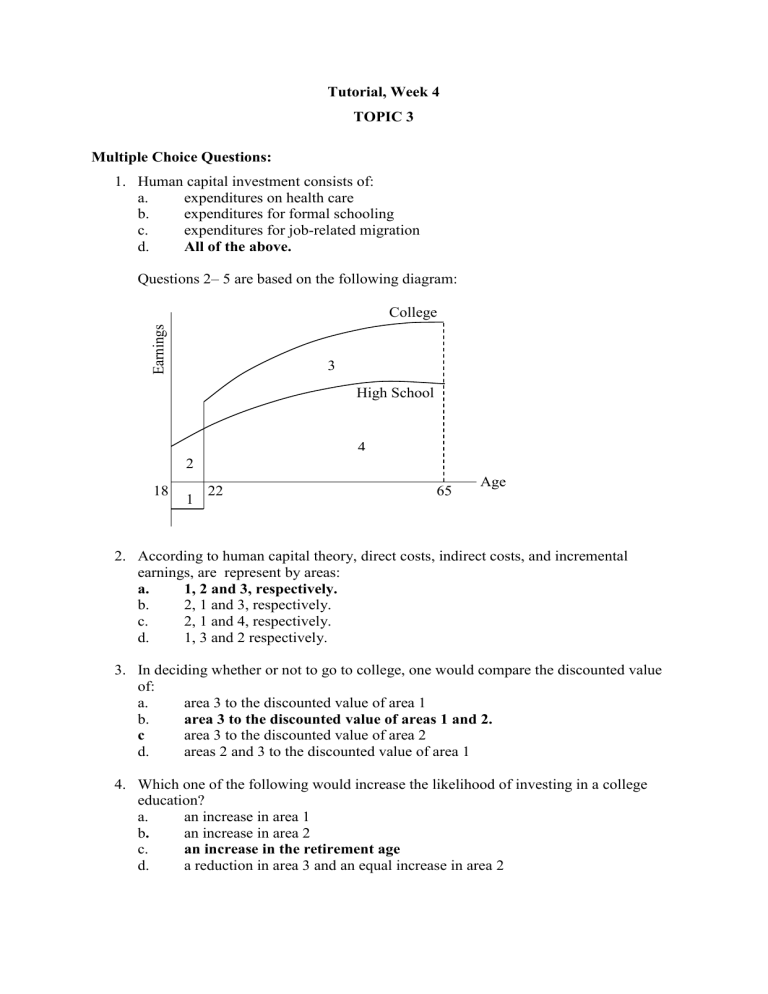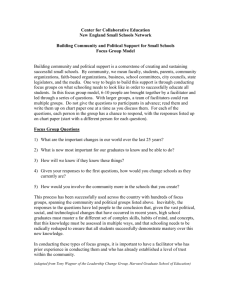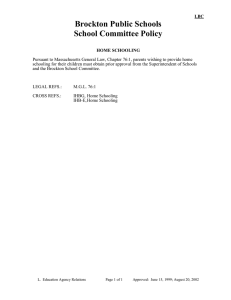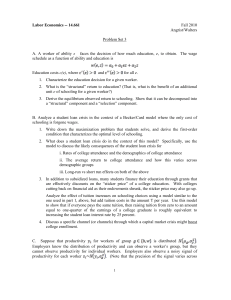
Tutorial, Week 4 TOPIC 3 Multiple Choice Questions: 1. Human capital investment consists of: a. expenditures on health care b. expenditures for formal schooling c. expenditures for job-related migration d. All of the above. Questions 2– 5 are based on the following diagram: Earnings College 3 High School 4 2 18 1 22 65 Age 2. According to human capital theory, direct costs, indirect costs, and incremental earnings, are represent by areas: a. 1, 2 and 3, respectively. b. 2, 1 and 3, respectively. c. 2, 1 and 4, respectively. d. 1, 3 and 2 respectively. 3. In deciding whether or not to go to college, one would compare the discounted value of: a. area 3 to the discounted value of area 1 b. area 3 to the discounted value of areas 1 and 2. c area 3 to the discounted value of area 2 d. areas 2 and 3 to the discounted value of area 1 4. Which one of the following would increase the likelihood of investing in a college education? a. an increase in area 1 b. an increase in area 2 c. an increase in the retirement age d. a reduction in area 3 and an equal increase in area 2 5. Suppose there is now a 25% likelihood that a person’s work career may be interrupted for ten years after schooling has been completed. In the diagram above, this development would: a. have no impact c. shrink area 2 b. shrink area 1 d. shrink area 3 6. At the optimal amount of education, the internal rate of return on education is: a. maximized b. equal to the market rate of interest. c. higher than the market rate of interest d. lower than the market rate of interest 7. The private rate of return on human capital may _____ the social rate because _____. a. understate; schooling is subsidized b. understate; schooling provides external benefits c. overstate; schooling provides external benefits d. overstate; schooling and ability are positively correlated 8. In the case of general training, the wage rate during the training period will be _____, while the post-training wage will be _____. a. W1; W3 b. W1; between W2 and W3 c. W2; between W2 and W3 W3 MRPt d. W2; W2 9. In the case of specific training, the wage rate during the training period will be _____, while the post-training wage will be _____. a. W1; W3 b. W1; between W2 and W3 c. W2; between W2 and W3 d. W2; W2 W2 MRPu W1 Training period Posttraining period Time 10. A firm that provides specific training to its workers: a. must reduce the wage during the training period, effectively forcing the worker to pay for the training b. may be prevented by the minimum wage from paying a wage above marginal revenue product during the post-training period c. will likely provide more training to those who have less formal education d. has a stronger incentive to reduce employee turnover than firms that provide only general training Discussion Questions 1. Direct costs = $1000 for books and tuition. Indirect costs (indirect costs) = earnings foregone= $8000 per year. Incremental earnings in each of the 3 years (area 3) = $13000 -$8000=$5000 (note that direct costs are not included) . Hence, Floyd should enroll in the course. NPV = - (1,000 + 8,000) + 5,000 / 1 + 0.1 + 5,000/(1 + 0.1)2 + 5,000/(1 + 0.1)3 = 3434.26 2. A is low ability person. He has low mental/physical talents and/or low motivation and self-discipline. His demand for schooling is DHCA. B is a high ability person. He has a greater demand for schooling at DHCB because he can better translate schooling into higher productivity and earnings. His demand schedule lies to the right of A’s. For a given interest rate i1, B will obtain more schooling which will compound the earnings differential between low and high ability persons. Use diagram Fig 4.6 from text. 3. Discuss a) Education: Investment or consumption? Not all education expenditures are an investment because some part is a consumption expenditure. Courses such as music appreciation yield consumption benefits rather than investment benefits. By ignoring the consumption benefits of education, researchers overstate the investment costs of education and understate the rate of return. b) Non-monetary benefits Studies that only examine the earnings of high school and college graduates understate the rate of return for two reasons. College graduates have greater fringe benefits as a percent of pay than high school graduates. College graduates tend to work in more pleasant surroundings and have more interesting jobs than high school graduates. c) Screening Hypothesis The screening hypothesis argues that schooling increases earnings not by increasing productivity but providing a way to identify high quality workers. Screening does not affect the private rate of return, since college graduates still have higher earnings. The social rate of return is overstated, as screening does not increase productivity. The empirical evidence shows screening appears to play a small role.



